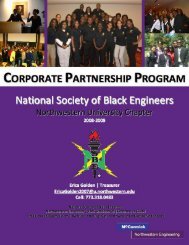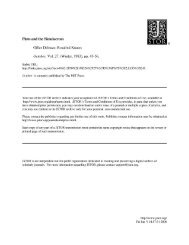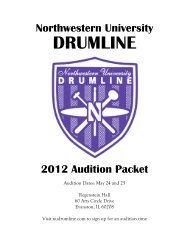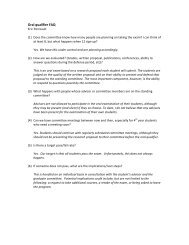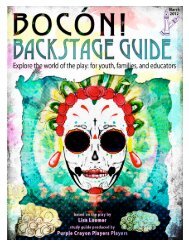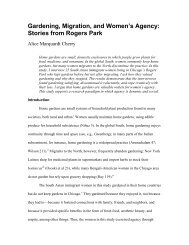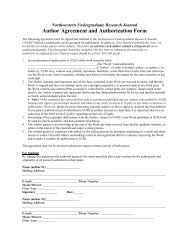research - Associated Student Government, Northwestern University
research - Associated Student Government, Northwestern University
research - Associated Student Government, Northwestern University
You also want an ePaper? Increase the reach of your titles
YUMPU automatically turns print PDFs into web optimized ePapers that Google loves.
ABSTRACTon twelve months of creative <strong>research</strong> under the title,ROOTS of EARTH, which has revealed to me the significanceof <strong>research</strong>ing the emotional memories tiedto questions of home, faith, and identity. Initially, the<strong>research</strong> took form by diligently looking at significantmoments in my personal history (including autobiographicalmoments and memories) and organizingthem into the aforementioned categories of home, faithand identity. From there, I magnified these events,exploring their connections with poignant momentsand relationships in my life, and engaged in dance, andmusic and theatrical exploration in order to deepenmy understanding of these moments. By fusing thesemulti-sensory products of <strong>research</strong>, I created a cohesiveevening of dramatic theatre. I presented this theatrepiece as a culmination of <strong>research</strong> in February 2012, toan audience of student and professional peers for review.After this solo presentation, I move into the arenaof ensemble storytelling, wherein I transfer the choreographic,musical, and theatrical ideas I developed in thestudio, to a group of dedicated actor/dancer/musicians.The methodologies for <strong>research</strong> in the rehearsal roomwill be based on the principles of devising work in aform I call intentional storytelling. In this performancedevelopment technique I created during the course ofan Undergraduate Research Grant, the creation of scene,character, and dramatic moment requires improvisationand collaboration: the ensemble decides, collectively,what each scene in the show needs to accomplish foreach character (the intention of the scene), and thenpulls from the plethora of artistic capacities of our actorsto create the drama. The performance, modeled onthe presentation of my solo <strong>research</strong>, can take the formof comedy, dance, physical gesture, spatial play, music,song, or poetry, all in service to the singular and simpleintention of each moment. Therefore, what maintainsthe show’s cohesiveness is the ensemble’s service to intention.My final <strong>research</strong> question, in which I ask howmeaning can be transferred from artist to audience,dictates the organization and presentation of this work.My hypothesis is that story is the ultimate link betweenhow an audience and artist make mutual meaning withina performance. Story, as it functions in performanceis, essentially, drama. Drama occurs when two characters,emotions, or worlds collide in conflict and then, bywhatever theatrical means, resolve. Therefore, though itmay be unconventionally told through multiple media,the dramatic story of ROOTS of EARTH will be reliablypresent in every moment. Effectually, this story modelinvites the audience to both witness and connect to acharacters’ growth, relationships and, ultimately, transformation.ROOTS of EARTH opens with an omniscientcharacter who introduces the thematic questions of theplay (not unlike the Greek chorus of the Theban Plays),VOLUME 7, 2011-2012as the ensemble comes to life inhabiting charactersof a mythic forest whose trees sing forgotten lullabiesand its people are doomed to lost wondering: two sisters,whose energies ride silent from the exhaustion ofhomelessness, dance and pull at each other in desperateneed of security; oppositely, three explorers bouncethrough space in farcical play in search of adventure,until their naive stamina dissolves and they are forced torealize their undeniable aimlessness. They are mythicallegories for our human struggle to accept the lonely,wandering fate of our condition. Later in the piece, theomniscient narrator intervenes as one character spiralsinto fear in her realization of her loneliness, teachingher to find stability within her own equilibrium. In achilling act, she opens her mind as the entire ensemblemoves inside to face the dark fears of her dreams. Eachof these characters is modeled from important personalrelationships that influenced my solo studio work, andtheir journeys bring to life the hypotheses I write as Iask questions about making meaning of my own autobiographyand memories.ROOTS of EARTH’s storytelling emphasis inintention-based origination departs from the work ofthe aforementioned artists, taking on a mythic form. Itbecomes a unique, genre-synthesizing performance thatemphasizes dramatic allegory in a cohesive story aboutpeople. In its incredibly specific, idiosyncratic sourceand presentation, this work rejects cultural boundariesand harnesses the sincere voice of the individual onthe global stage. This genre, unlike others, is entirelyinclusive as the allegories of the human experience areuniversal, crossing all forms of cultural boundaries.BibliographyAlbright, Ann Cooper. “Auto-Body Stories: Blondell Cummings and Autobiography in Dance.”Meaning in Motion: New Cultural Studies of Dance. Ed. Jane Desmond. Durham: DukeUP, 2003. (179- 205) Print.Cooper, Pamela J., and Rives Collins. The Power of Story. South Melbourne: MacmillanEducation Australia, 1994. Print.Dixon-Stowell, Brenda. “Blondell Cummings: ‘The Ladies and Me.’” The Drama Review 24.1(1980): 37-44. MIT Press. Web. 18 October 2011.Everest, James. “An Interview with Choreographer Emily Johnson, about THE THANK-YOUBAR” catalystdance.com. catalystdance, n.d. Web. 6 December 2011.Gere, David. “29 Effeminate Gestures: Choreographer Joe Goode and the Heroism ofEffeminacy.” Dancing Desires. Ed. Jane C. Desmond. Madison: <strong>University</strong> of WisconsinPress. (349-381) Print.“Go For What You Know.” Free to Dance. Dir. Adam Zucker. PBS, 2001. Videocasette.Grace, Sherrill. “Theatre and the AutoBiographical Pact: An Introduction.” Theatre andAutobiography: Writing and Performing Lives in Theory and Practice. Ed. Sherril Graceand Jerry Wasserman. Vancouver: Talonbooks, 2006. (13-29) Print.Hanna, Judith Lynne. “New Moves for Men.” Dance, Sex and Gender: Signs of Identity,Dominance, Defiance and Desire. Chicago: <strong>University</strong> of Chicago Press, 1988. Print.Kourlas, Gia. “Exploration with Myth, Memory, and Movement.” Rev. of The Thank-you Bar,perf. Emily Johnson. New York Times 11 November 2011. Web.McNamara, Joann. “Dance in the Hermeneutic Circle.”Researching Dance: Evolving Modes ofInquiry. Ed. Sondra Horton Fraleigh and Penelope Hanstein. Pittsburgh: <strong>University</strong> ofPittsburgh Press, 1999. 162-187. Print.Miller, Tim. Body Blows: Six Performances. Madison: <strong>University</strong> of Wisconsin Press, 2002.Print.Phelan, Peggy. “Tim Miller’s My Queer Body: An Anatomy in Six Sections.” Theater: Duke<strong>University</strong> Press Online Journal. 24.2. (1993): 30-33. Web. 6 December 2011.NORTHWESTERN UNDERGRADUATE RESEARCH JOURNAL47



